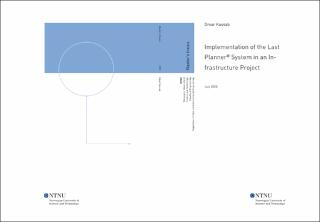| dc.contributor.advisor | Lædre, Ola | |
| dc.contributor.author | Kassab, Omar | |
| dc.date.accessioned | 2021-09-20T16:18:15Z | |
| dc.date.available | 2021-09-20T16:18:15Z | |
| dc.date.issued | 2020 | |
| dc.identifier | no.ntnu:inspera:50403903:34501090 | |
| dc.identifier.uri | https://hdl.handle.net/11250/2779446 | |
| dc.description.abstract | Siden etableringen av Last Planner®-systemet (LPS) av Ballard og Howell, er det utført flere studier for å evaluere implementeringen av LPS i mange byggeprosjekter. Imidlertid har få studier registrert implementeringsprosessen i infrastrukturprosjekter. Denne studien undersøker implementeringen av LPS i et infrastrukturprosjekt (Minnevika Bridge-prosjektet), oppdager utfordringene som oppstår under implementeringen, og foreslår tiltak for å overvinne disse utfordringene. Flere datainnsamlingsmetoder ble brukt; nemlig en enkelt casestudie, en litteraturgjennomgang, ikke-deltaker / deltakerobservasjoner, syv semistrukturerte intervjuer og to undersøkelser.
Studien avdekket at prosjektet fulgte prosessen med beste praksis for implementering av LPS nevnt i litteraturen. Videre opplevde prosjektet utfordringer beskrevet i litteraturen som har en tendens til å oppstå når de innfører LPS, på lik linje med de som er rapportert fra andre byggeprosjekter, inkludert deltakernes motstand mot systemet og deltakernes forpliktelser overfor det nye systemet. Studien avsluttes med foreslåtte tiltak for å overvinne disse utfordringene, som tilstrekkelig trening, åpenhet overfor LPS, og bruk av inkrementell strategi når du bruker Key Performance Indicators (KPIs). Til slutt representerer forfatteren utfordringer som ikke er tydelig beskrevet i litteraturen (f.eks frykt for ansvar når de gjør forpliktelsene). Til slutt foreslår forfatteren en ny indikator (Trust-Doubt-indikator) som kan brukes til å spore tvil og tillitsholdninger til LPS og andre deltakere. | |
| dc.description.abstract | Since the establishment of the Last Planner® system (LPS) by Ballard and Howell, multiple studies have been conducted to evaluate the implementation of the LPS in many construction projects. However, few studies have recorded the implementation process in infrastructure projects. This study investigates the implementation of the LPS in an infrastructure project (Minnevika Bridge project), detect the challenges that arise during the implementation, and suggest measures to overcome these challenges. Several data collection methods were used; namely, a single case study, a literature review, non-participant/participant observations, seven semi-structured interviews and two surveys.
The study revealed that the project followed the best practice process map for the LPS implementation mentioned in the literature. Moreover, the project experienced challenges described in the literature that tend to arise when adopting the LPS, similar to those reported from other construction projects, including, the participants’ resistance to the system and participants’ commitments towards the new system. The study concludes with suggested measures to overcome these challenges, such as sufficient training, openness towards the LPS, and using the incremental strategy when using the Key Performance Indicators (KPIs). Finally, the author represents challenges that are not clearly described in the literature (e.g. fear of responsibility when making the commitments). In the end, the author suggests a new indicator ( Trust-Doubt indicator) which can be utilised to track the doubt and trust attitudes towards the LPS and other participants. | |
| dc.language | | |
| dc.publisher | NTNU | |
| dc.title | Implementation of the Last Planner® System in an Infrastructure Project | |
| dc.type | Master thesis | |
